How Cold Does it Have to Be to Freeze to Death? A guide.
I have traversed the north woods of Michigan for 31 years now. I’m familiar with cold weather and have heard the stories of those who didn’t make it.
People can freeze to death at any temperature under 32 degrees F (0 degrees C). Most hypothermia deaths occur in temperatures from 50 and 30 degrees F. Most cold-weather deaths are from days of exposure or short-term exposure to cold temperatures in wet conditions.
Over the past 30 years, an average of 27 people a year have died from the cold, according to this info page at the National Weather Service. Cold weather can quickly turn dangerous if you aren’t prepared for it. Here are tips and stories about cold weather danger.

What Temperatures are Actually Dangerously Cold?
Temperatures below the freezing point (32F) can be dangerous in short-term exposure if you are not properly dressed for them. Wind will greatly increase the danger of cold weather because it increases your body’s heat loss, making the air feel colder than it actually is.
Most cold-weather deaths are simply from lower temperatures than you are used to. Most people are not prepared for conditions they are not used to. That’s why cold weather deaths can happen anywhere in the US.
Here’s a shocking statistic, a similar number of cold-weather deaths are reported from both the southern and northern US. In the last 5 reported years, 2020 to 2015, 159 people died in the US from cold weather. Fifteen of them were in Texas.
I will say that winter temperatures 20 degrees lower than you are used to are when challenges start to arise. That’s when you feel really cold, and may not have the gear to handle it. That’s when you may need an additional layer of clothing. To a point, your body can adjust to a lower air temperature, but sudden drastic changes you are not prepared for, that’s what pose a risk.
Most of the cold Weather deaths in the US happen with air temperatures over 20 degrees F. That’s not really all that cold. Right now, it’s -3 degrees F in my front yard, and the water supply to my bathtub seems to have frozen last night.
It’s cold enough that I actually need to wear my hat and gloves to do my morning chores outside. In temperatures around 0 degrees F, my fingers can get Chill Blains, minor nerve damage from almost freezing, in a half-hour or less without gloves.
My dad has chill blains on his feet. Now, his feet can’t handle much cold because of nerve problems. That all came from one cold day fishing for winter steelhead. If you experience pain from cold, get warm. Most of us outdoorsmen in the north have had pain in the extremities from cold.
Generally either the fingers or toes go first. An aching or burning pain in the fingers, toes, or ears is a sure sign that you are experiencing Chill Blains, the precursor to Frost Nip. Frostnip is when the inner layers of skin begin to freeze, and it means frostbite is not far behind.
I’ve not seen frostbite, but I have seen frozen skin. The coldest I’ve ever been in was about 2 below zero with a 55-60 mph wind. I was 15. The wind chill factor was about -40 degrees F. I was out checking my trapline near the marsh. I remember my eyelids freezing shut at one point when I blinked.
That’s why I always pack a neoprene snow mask when I’m in the woods these days. In the cold that day, 20 minutes of exposure without proper clothes could have meant an onset of frostbite. But, with the proper dress, an actual temperature of -40 degrees F can be manageable.
My Friend Nearly Froze in Montana
I met a guy named Jack. Now, Jack is basically a real-life, modern mountain man. He lived for years in a canvass tent in the mountains of Montana; hunting and fishing with his loyal dog. He told me a story about the day he thought he was gone for good in the rural mountains near Nye Montana.
“The weather had just turned cold, cold enough to freeze the mountain lake solid overnight. I vetured out on the ice to catch some fish after a few days. It was bitter cold and the ice was thick, or so I thought. There came a point at which I fell through the ice in the middle of the lake. I assume the cold water hurt, but all I could think about was getting back on the ice. I managed to crawl out and get back to shore, but things were going downhill fast. I had a fire kit in my pack, but my fingers coldn’t work a lighter or match. My hands mostly quit working by the time I got off the ice. By the time I gave up trying to light the fire, my clothes were solid ice. I peeled off most of my cloths and tried to wring out some water. I was smart enough to have a box of handwarmers in my pack. With some effort, I partly tore and partly chewed them open and stuffed them beneath my cloths and into my inner pockets. With all I the effort I could gather, I desperately tried to keep moving, knowing that If I stopped, my body would shutdown and go unconcious soon after. The wind was intense, but I stayed jogging in place and doing jumpingjacks to try and keep my brain and heart going. I figure it was close to the end by the time I felt the warmth of the handwarmers radiating against my core. Fifteen more minutes and my body started to gain in teprature. I figure it was an hour after falling in before I had my whits back and could actually start a fire.”
That was quite the story to hear over a campfire in the snowy mountains. And you betcha I always make it a point to bring a box of hand warmers in my winter pack after hearing it.

How to Dress for Cold Weather
An approximate guide to winter dress is to add a base layer for every 10 degrees lower than 30 F. In freezing temperatures, you should always have a warm hat, gloves, and a coat nearby. Waterproof boots are a must for cold weather because show and ice will get your feet wet.
At 30 degrees, I usually just wear jeans, a flannel, and a hoodie. If I’m going to be out for more than an hour I’ll at least bring my gloves, whether or not I’ll wear them depends on if I’m touching wet or snowy things. I will wear either muck boots or cheap rubber boots.
At 20 degrees, I’ll add a T-shirt for a base layer, probably wear my gloves, and may wear a knit hat under my hoodie. I’ll still just wear jeans if I’m being active and not walking in deep snow. It’s probably time for my neoprene muck boots.
When it gets down near zero, it’s time for the big coat with a hood, thick gloves, and maybe thick socks. If I’m not being too active, I’ll add long underwear as a base layer.
The big thing is whether or not I’m being active. It can be 5 degrees F out and if I’m shoveling show from the driveway, I need to take off my hat and coat. But, if it’s 5 degrees F and I’m sitting waiting for a deer in the woods, I’m adding my Carhart bibs, extra socks, and maybe a snow mask.
The most dangerous thing in cold weather is to be wet. The human body can lose heat almost 25 times faster when wet. Water fills in the air space in your winter clothes, destroying up to 80 percent of its insulation ability even after wringing it out.
I know that I am making cold-weather sound harsh, and it can be, but realize that there are about as many deaths from lightning strikes in the US in the past 30 years.
The great thing about cold weather is that, unlike a lightning strike, we know where it’s going to be when it’s going to get there, and can do something about it.
In 1915, Ernest Shakleton and his entire sailing were stranded in the Weddell Sea of Antarctica without a ship, and with almost no supplies. The hardships were terrible, but not a man was lost on that famous and fateful expedition. Still, there are those the cold seeks to claim.
They Found them in the Spring
My friend Jack told me another story. This one grimmer, reminding us all about the principles of survival and the importance of preparation, but also of the ruthlessness and sheer power of nature.
We were driving through a large valley, down a rural road in on the way to Bad Canyon to hunt Mule Deer. I, the cameraman, was playing with my equipment, prepping for the week off-grid. Jack pointed out the snow fences and told me they were to keep the snow drifts out of the road. Still, he said this road often gets closed in the winter due to impassable snowdrifts. He then told the story of the unlucky duo who didn’t know it was closed.
“An elderly couple was found just a few miles from here several years back. They had been missing for months, and nobody knew what happened utill their remains were found and a note was discovered on the dashboard telling their story. The road had been closed for a while due to drifting snow over 10 feet in a lot of the valley. The couple weren’t from around here, and didn’t know the area. Somehow, the man missed the road closed sign. Perhaps it was too snowy to see it, or perhaps it had blown over. the man drove for miles dowh through deep snow, and eventually got his car completely stuck. They waited for a day, but saw no one else come down the road. Meanwhile, the snow piled higher in the valley and the wind blew hard. The old couple decided to stay with the car, not being prepared, nor very cappable of walking out. They had no supplies, food or water. The man had been running the car for heat untill he smelled too much exhaust coming in the snowbound vehicle. Then after waiting a few hours, start it again. This went on for a several days, untill they were ourt of fuel. Meanwhile, the storm raged on. b y the fourth day, the old man woke to realize that his wife had passed in her sleep, either due to the cold or dehyudration. He took a pencil and scrap of paper, and wrote a bried explnation of what had happened, and penned his last whishes. In the note, He said he didn’t fear death and just wanted to go to sleep with his wife. They were found when the snow started melting almost two months later.”

Emergency Winter Supplies
If you live in an area where temperatures can get into the freezing levels, which is pretty much anywhere in the US, you need some sort of heater, a coat and knit hat, and a few extra blankets in your home.
Remember a few years back, the big winter storm that hit texas? Water pipes burst, people were hospitalized with hypothermia, and some people died from the cold. Whether or not you have a furnace, you really should have a backup heat source that doesn’t require electricity.
I recommend the Buddy Heater. It’s safe for indoor use, inexpensive, and will heat up an average home at least somewhat. Just recently, a friend lost power in -12 degrees F. A member of a local preparedness group ran out with a Buddy Heater, which was enough to heat the house and thaw partially frozen pipes.
They can run most of a day on a one-pound propane can, or they can be connected to a BBQ grill-size tank with an adapter. I actually heated my house for a month once on three 20-pound grill tanks during a year when we had a propane shortage.
When wandering out in the cold, have access to more gear than you need. You don’t need to carry it all with you, but there should at least be an extra jacket and blanket back at camp, or in the car. I keep a fire kit with some cedar kindling in my emergency pack, which is always nearby. Also, hand warmers.
do you have a decent map and compass in your car? You probably should. How about an emergency radio? I have a Baofeng radio with a magnetic antenna in my trunk, along with a charger and a list of commonly used channels that are likely to have someone hear a mayday call.
Do you at least have an extra vehicle charger for your cell phone? Always prepare for one step past normal, because that’s going to happen at some point. And remember, the greatest tool of survival is the human mind; its determination and creativity. That’s the only thing to ever beat the forces of nature.
